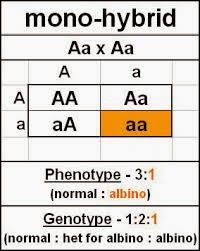Genotype - allele combination of an organism.
Phenotype - characteristics of an
organism.
Dominant allele - an allele that has the
same effect on the phenotype whether it is present in the homozygous or
heterozygous state.
Recessive allele - an allele that has an
effect on the phenotype when it is present in homozygous state.
Co-dominant alleles - pairs of alleles
that both affect the phenotype when in a heterozygote.
Locus - particular position on homologous
chromosome of a gene.
Homozygous - two identical alleles of a
gene.
Heterozygous - two different alleles of a
gene.
Carrier - an individual that has one copy
of a recessive allele that causes a genetic disease in individuals that are
homozygous for the allele.
Test cross - testing suspected
heterozygote by crossing with known homozygous recessive.
Monohybrid Cross with Punnett grid
Monohybrid Cross (rosyboas.to)
Multiple alleles
Some genes have more than two alleles
(multiple alleles).
Codominance (expressed equally in
phenotype).
Incomplete dominant (neither fully
expressed, blending).
Dominance order (Allele A>B>C).
ABO blood groups
Genotype IAIA gives
blood group A/IBIB gives group B
Neither IA or IB
are dominant over each other, another blood group is formed called IAB
Genotype IAi and IBi
give blood groups A and B
Blood Types (ib.bioninja.com.au)
Blood type A contains:
A antigen.
Anti B antibody.
Therefore, cannot have B or AB blood,
only A and O blood.
Blood type B contains:
B antigen.
Anti A antibody.
Therefore, cannot have A or AB blood,
only B and O blood.
Blood type AB contains:
A and B antigens.
Neither A nor B antibodies.
Therefore, this type is the universal
recipient.
Blood type O contains:
Neither A nor B antigens
Both antibodies
Therefore, this type is the universal
donor and can only have O blood
How sex chromosomes control gender
X chromosome is large and contains many
genes essential to both male and female development. Y chromosome is smaller
and has fewer genes. One gene, called TDF, is found on the Y gene only, and is
needed for testis and testosterone development. Females have 2 X chromosomes
and ovaries are developed and female sex hormones are produced. All of us get
mother’s X and daughters get father’s X while sons get father’s Y.
X and Y chromosomes
Some genes are present on the X
chromosome and absent from the shorter Y chromosome in humans.
Sex linkage definition
Sex linkage - gene controlling a
characteristic is found on a sex chromosome (associate trait with predominant
gender)
Inheritance of colour blindness and hemophilia
Females with normal color vision can be heterozygous,
possessing the dominant allele and recessive allele (that causes color
blindness). In this case, she is a carrier, but shows no signs of the blindness
due to the dominant allele masking her recessive one. She can also either be
homozygous dominant and again, she has normal color vision. It is very rare for
females to be homozygous recessive for color blindness, there is only a 25%
chance of happening.
For males, genes are found on the X and
not the Y. So, we have a 50% chance of getting color blindness. Even if we have
a recessive allele for blindness, the Y cannot mask this allele because it is
insignificant. Males will receive this condition if the X-linked recessive
allele is passed from mother since males always get the father’s Y.
Same case with hemophilia. For color
blindness, the notation is XB and for hemophilia it is XH. For
recessive, make the B and H not capitalized.
Sex-linked genes in females
Human female can be homozygous or
heterozygous with respect to sex-linked genes.
Female carriers of X-linked recessive alleles
Individual with recessive allele for
disease masked by condition of dominant allele, which means this individual is
a carrier. This is heterozygous, however, it can be passed onto next generation
and they will not suffer from defect.
Females can be carriers, 2 X chromosomes,
however, males cannot because the Y does not play a role and the genes are
found only on the X. So if males receive the defect from the mother, the male
will suffer from the defect.
Predict genotypic and phenotypic ratios of offspring of monohybrid crosses
X-Linked Punnett Grid (merckmanuals.com)
Blood Codominance Punnett Grid (fhs-bio-wiki.pbworks.com)
Pedigree Charts
In the case of a characteristic due to a
dominant allele, the characteristic tends to occur in one or more members of
the family in every generation.
A recessive characteristic is seen
infrequently, often skipping many generations.
Square for male, circle for female.
If square or circle is colored, means
they are affected with a disease; if dotted, means they are carriers.
For example Albino people have
homozygous recessive allele (pp) while normal have homozygous normal (PP) or
carriers (Pp).
If most of the males in the pedigree are
affected the disorder is X-linked.
If it s a 50/50 ratio between men and
women the disorder is autosomal.
If the disorder is dominant, one of the
parents must have the disorder.
If the disorder is recessive than
neither of the parents has to have the disorder as they can be heterozygous.




No comments:
Post a Comment